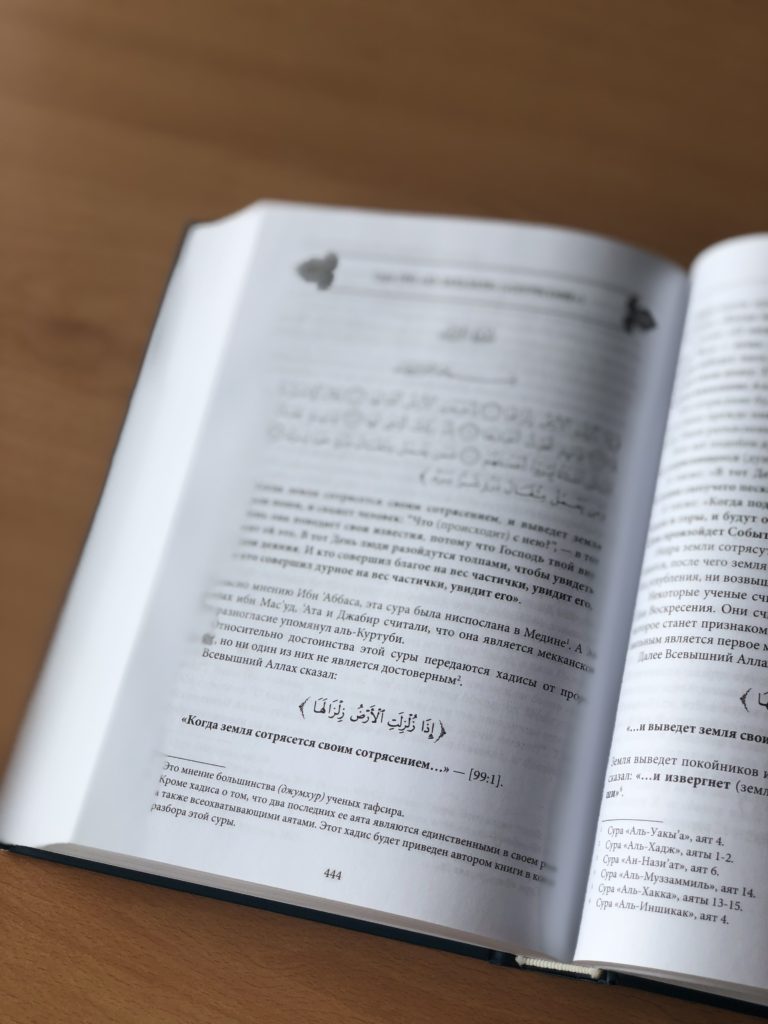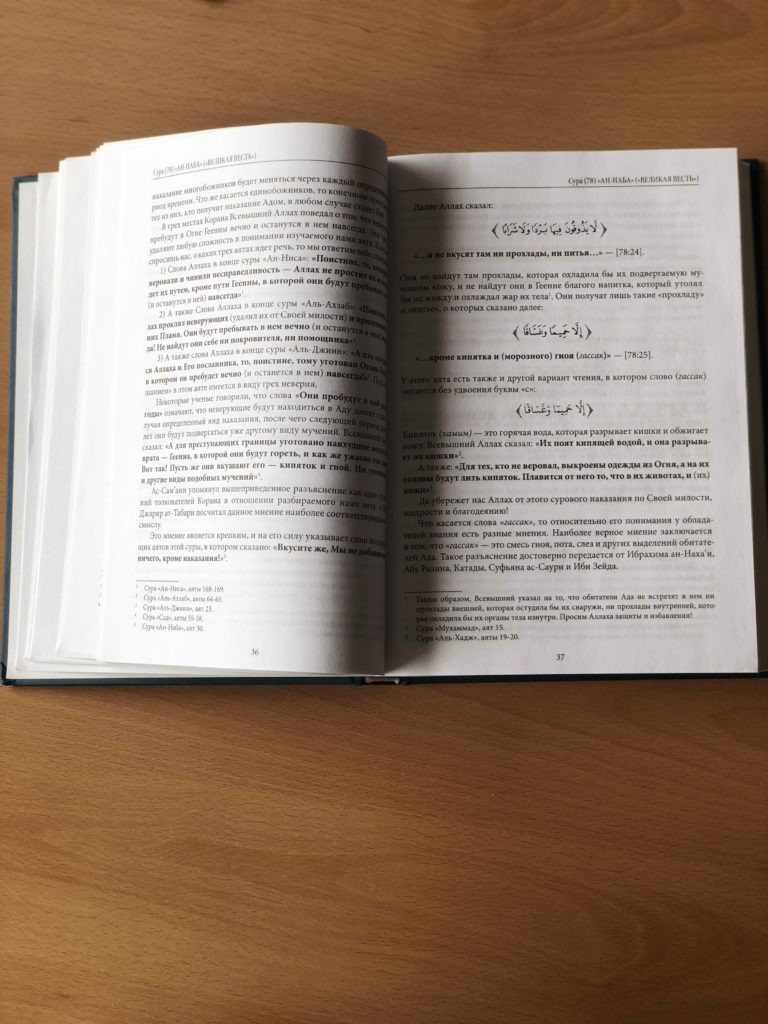This week’s post addresses Ozarenie ot znayuschego, sveduyuschego [Озарение от Знающего, Сведующего], a Russian translation of Fatḥ al ʿalīm al khabīr bi-tafsīr ‘al-juzʾ al-akhīr’, a tafsīr on the last juzʾ of the Qur’an by the Yemeni preacher Muḥammad ibn ʿAbdallāh Bājammāl. The translation is by a prolific Tatar preacher and translator known by the teknonymic name Ruslan Abu Ibrahim Tatarstani. Ozarenie ot znayuschego is one of a number of Salafi translations made available by Darulhadis, a private publishing house in Russia which is closely associated with Tatarstani himself, the name of which references the Dār al-Ḥadīth al-Khayriyya madrasa in Dammaj in Yemen. There is not a great deal of publicly available biographical information about Tatarstani, who currently lives in Yemen. Having said that, some information about his educational background can be found in his book Kakim ya nashel Dammadj [Каким Я Нашел Даммадж], in which he writes about the establishment of the Salafi movement in Yemen and its inner conflicts within the country and beyond.
The aforementioned Dār al-Ḥadīth al-Khayriyya madrasa was among the first of Salafi educational institutions established in Yemen. It was founded by Shaykh Muqbil ibn Hādī al-Wādiʿī, whose teachings were oriented towards promoting the legacy of Shaykh Rabīʿ al-Madkhalī, a well-known Salafi preacher and a propagator of apolitical and quietist Salafi puritanism. The Darulhadis publishing house that takes its name popularizes various Salafi shaykhs, with a focus on Yemeni authors including the aforementioned Shaykh Muqbil as well as less well-known Yemeni preachers such as the author of this tafsīr, Shaykh Bājammāl. The tafsīr covers the last part of the Qur’an, known as the juzʾ ʿamma, which mainly comprises short suras that are memorized by Muslims because of their common usage in the ritual practice.
Tatarstani’s rationale for selecting this tafsīr for translation for a Russian-speaking audience can be understood as rooted in the general vision of Darulhadis, which includes among its stated aims ‘the selection of useful topics and issues, the coverage of which is necessary for Russian-speaking Muslims.’ In his introduction to Ozarenie ot znayuschego, Tatarstani asserts that one of the main strengths of Shaykh Bājammāl’s tafsīr is its theologically verified approach, according to which the author provides a variety of opinions that clarify the meaning of the āyāt and subsequently evaluates them either by reference to past authorities or according to his own opinion.
In terms of Russian-language translations of the Qur’an and its exegesis, this translation is innovative in that it addresses the various qirāʾāt (readings) and the interpretative possibilities these engender. In some cases, the variations provided by the qirāʾat may deepen and widen the meanings of a particular āya, as in the case of Q 97:4 mentioned in the book. For instance, the qirāʾat ʿĀṣim (in narrations of Ḥafṣ and Shuʿba) is rendered ‘On this night angels and spirit (i.e. the angel Jibril) come down by permission of their Lord for any sorts of orders’; another variant of Ibn ʾAbbās offered in the book reads as ‘… and each angel has his [special] order’ (pp. 425–426). Through this slight difference, the meaning of the verse acquires an additional dimension that enlarges the reader’s overall understanding. In some cases, although various qirāʾāt are mentioned in Ozarenie ot znayuschego, they are rejected on the basis of reference to particular authorities of the past such as al-Ṭabarī (sometimes inconsistently referred to as ‘Ibn Jarīr’) (as, for example al-Kisāʾī al-Khalāf’s variant of reading, on p. 426). By taking the role of the editor Tatarstani often intervenes into the original text in order to clarify and add additional information. However, in this case he does not see the need to explain the practicalities of discussions on the variant readings taking place in the source text, but just generally allows polyvalent opinions to be present in the text.
Among the sources cited in Bajammāl’s tafsīr, we find the standard preferences that correspond to what is commonly known as al-tafsīr bi’l-maʾthur (or al-tafsīr bi’l-riwāyah), such as al-Ṭabarī, Ibn Kathīr, al-Baghawī, and al-Suyūṭī. However, the translator’s voice can also be heard quite loudly in this translation, partly through the addition of paratextual information that includes the explanation of the specifics of this tafsīr. In the translator’s preface Abu Ibrahim Tatarstani asserts the importance of seeking understanding of Qur’anic meanings by recourse to Qur’anic āyāt, reliable ḥadīths, and the words of various Islamic authorities such as Ibn Taymiyya. (His style of writing, which is heavily influenced by Islamic Arabic conventions, is somewhat peculiar: for instance, he has a habit of adding the phrase ‘amma baʿd’ after the praise of God and His messenger in the beginning of his books, which is translated as ‘a zatem’ [‘and thereafter’]). The translation also includes a short additional chapter written by Tatarstani that gives a brief history of the development of the science of tafsīr. In this, Tatarstani provides his own personal five-fold classification of various contemporary approaches to the Qur’an’s interpretation, and makes apparent his opposition to other schools of creed, giving clear warnings against Ashʿarī, Muʿtazilī, and Shīʿa theologians and scholars. This is not altogether surprising, as Tatarstani has become notorious for his use of al-jarḥ (‘discreditation’/‘impugning’) in the Russian-speaking milieu, a term he borrowed from ḥadīth criticism terminology and applied to various Muslim scholars, preachers and fellow Muslims, and which can be observed in his warnings and appraisals of specific authors.
While Bājammāl’s tafsīr is praised by Tatarstani, it is important to note that he did not consider Bājammāl’s approach comprehensive enough for a Russian-speaking audience, and thus added in additional references throughout the text from such Salafi-admired mufassirs as Muḥammad al-Shinqīṭī and Muḥammad b. al-ʿUthaymīn, among others. This perhaps can be seen as an attempt to widen the approach of the original author and to attract more readers through bringing in names that are well-known and respected in Salafi circles from various geo-cultural settings such as Saudi Arabia and Mauritania, but it is also another clear example of Tatarstani’s intervention into the source text.
Among the common Salafi hermeneutical features, often observable in Salafi exegetical works, is the differentiation of tawḥīd in four or three categories. In Ozarenie ot znayuschego, they include four: Oneness in Essence, in Names, in Attributes, and in Actions. (For more on this, see Mykhaylo Yakubovych’s presentation on Saudi sponsored tafsīr and translations). There are also specific digressions added to the source text by the translator, for example in the form of questions asked in regard to a certain issue related to a given āya and answers provided by favoured exegetes such as Shaykh Ibn al-ʿUthaymīn.
Some of Tatarstani’s translation choices might be challenged from the viewpoint of modern Russian language usage, its vocabulary and stylistic features. Some could even be viewed as problematic within the conventional Salafi lexicon. For example, on one occasion Tatarstani uses the phrase ‘уединяли Аллаха’ (p. 533), perhaps intending to say ‘[they]did not believe in the Oneness of Allah’, but instead actually saying ‘[they] secluded Allah’. The word уединяли is based on the root “един” which means ‘one’. However, in Russian it is used to denote physical seclusion, isolation or disconnection and thus cannot be used to refer to the Oneness of Allah. There are other examples of lexical problems that make the Russian translation sound somewhat awkward, such as Q 85:16 ‘… Премного вершащий то, что пожелает’ [‘Excessively/ overmuch Doer of whatever He wills’; Faʿʿālun li-mā yurīd] (pp. 208, 229). This is a result of Tatarstani’s desire to transfer the exact morphological features of Arabic to the target text. In this example the exaggeration pattern (ṣīgha al-mubālagha) faʿʿāl is translated by adding the word премного (premnogo, an archaic word that means ‘excessively’, ‘overmuch’). Another problem is a direct transfer of the logic of the Arabic syntax to the target text, as in the phrase ‘поклоняющимся Аллаху, неузаконенными поминаниями’ (p. 554) that can be roughly translated to English as ‘… [extreme Sufis], worshiping Allah by illegal remembrance’.
Significantly, Tatarstani did not rely on existing Russian Qur’an translations associated with the Salafi trend, such as Koran: Perevod Smyslov by Elmir Kuliev or Koran: Perevod Smysla Ayatov i ih Kratkoe Tolkovanie by Abu Adel. While some suras do seem to resemble Kuliev’s rendition, in many instances Tatarstani prefers to diverge from the aforementioned translators. For example, in the case of Q 106:1, li-īlāfi qurayshin, Tatarstani’s translation is in implicit conversation with those of Kuliev and Abu Adel. While the latter two are in agreement in rendering īlāf as единение [edinenie], (‘unity’), Tatarstani prefers to translate it as привыкли [privykli] (from the noun привычка [privychka]; ‘a habit’/‘to get used to’). In a footnote to this āya, without mentioning the names of any other translators, Tatarstani clarifies why he has made this specific choice. The fact that he feels that he has to justify his choice here intimates that he is aware that Kuliev and Abu Adel have both opted to translate the phrase differently. Tatarstani also goes against established translational practices adopted in the Russian language, for example using Науауи (‘Nawawi) instead of Навави (‘Navavi’), perhaps aiming to achieve a more authentic Arabic pronunciation than is provided by the conventional term used by translators from Arabic to Russian.
Overall, it can be said that Abu Ibrahim Tatarstani’s translation of Ozarenie ot znayuschego provides quite an interesting example of transnational Salafism, especially since it does not depend on a general link to Saudi Arabia for its main orientation. It also confirms the complexity of Salafi Islam, which is far from being a monolithic trend and rather consists of a variety of divisions, different in their political agendas, authoritative references, educational approaches, and the Qur’anic tafsīrs and translations that they favour.
Elvira Kulieva



